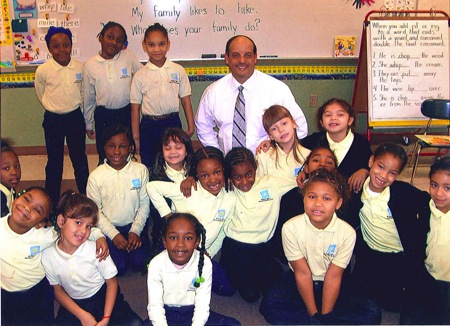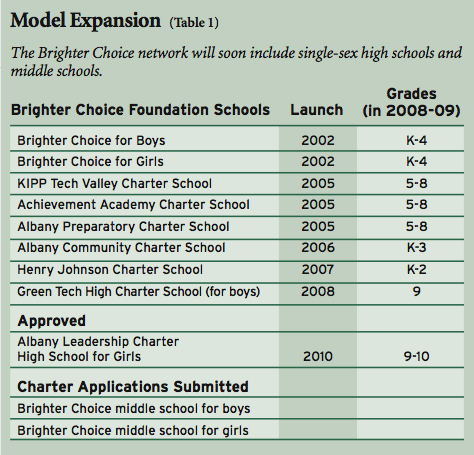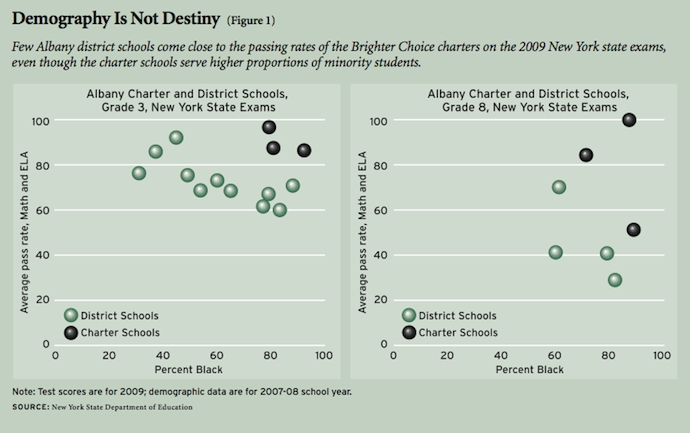
“Well, I said we’d go from 10:30 to noon,” Bob Ward reminded the crowd, trying to end a sold-out public policy forum on “Charter Schools in New York and the Nation.”
The session in the second-floor seminar room at the Nelson A. Rockefeller Institute of Government in Albany had already featured a detailed presentation of “charter facts” from the new executive director of New York’s Charter Schools Institute and a dozen friendly questions from the mostly pro-charter audience. Ward, the dignified and cerebral deputy director of the institute, seemed anxious to wrap things up. “So, thank you—”
He stopped in midsentence. A hand had shot up at the back of the crowded room. “Eva, did you want to ask a question?” he asked.
All eyes turned to the dark-haired woman sitting on a folding chair along the back wall of the room. Some eyes rolled, as most of the group knew Eva Joseph, the embattled superintendent of Albany Public Schools (APS). They had seen her at countless education forums, on the local nightly news, and in the daily paper at every turn of the school budget clock, determinedly defending her district and, increasingly, railing against charter schools. “I’ll make it quick,” said Dr. Joseph. “I do want to thank you for acknowledging the situation in Albany, but going to the heart of what’s real, we have 10 charter schools in Albany with a total public school population of 10,500 students. Compare that to 23 charter schools in the Big 5, with the exception of New York City. Buffalo, Syracuse, Rochester, Yonkers. Twenty-three total charter schools and you total up their enrollment. The proliferation here. The oversaturation, per pupil and per capita, is glaring. And it has serious implications for the district. It destabilizes it on many fronts….”

Standing a few feet away, as Joseph plunged on, a man leaned against the wall, smiling. It was not a smug or obvious smile, nor the smirk of a man who was mocking or scornful. Tom Carroll was smiling because he had heard the speech before and because he knew, as founder of the charter school foundation that had siphoned off nearly a quarter of Dr. Joseph’s 10,500 students, that he was at least an immediate cause of the vitriol. It was the smile of victory.
The Holy Grail of Charter Schooling
During much of the previous nine years, Carroll had overseen the launch of eight charter schools (see Table 1) in Albany, a small city (pop. 94,172), as Joseph suggested, for so many charters (to see additional images of the schools and their students please click here). Joseph, who began her Albany tenure as an assistant superintendent in 1997 and took the top job in September 2004, had been engaged in the charter battle for most of that time. “Fifth Albany Charter School Approved” was the headline just two months after she became superintendent. “SUNY adviser suggests city district cut staff, rent out extra space as students depart.”
 What had been especially maddening for Dr. Joseph and her school board, which issued routine condemnations of the charters, was not just the presence of so many of the new schools—“the proliferation, the oversaturation”—but that they were so good. The destabilization was real and deep, creating not just viable, but quantifiably better, educational alternatives for children. And this is the singular accomplishment of Carroll’s charter organization: they had found the Holy Grail of charter schooling, quality and scale.
What had been especially maddening for Dr. Joseph and her school board, which issued routine condemnations of the charters, was not just the presence of so many of the new schools—“the proliferation, the oversaturation”—but that they were so good. The destabilization was real and deep, creating not just viable, but quantifiably better, educational alternatives for children. And this is the singular accomplishment of Carroll’s charter organization: they had found the Holy Grail of charter schooling, quality and scale.
It is still an elusive goal for the charter school movement, which has grown to include more than 4,500 schools and 1.3 million students in 40 states and the District of Columbia. This remains a drop in the public school bucket (nationally there were more than 94,000 public K—12 schools and more than 49 million students in 2007), which is why “market share” is considered a crucial milestone, one of the few ways to pinch traditional schools in their pocketbooks. According to the National Alliance for Public Charter Schools, in 2007 New Orleans had reached 55 percent market share, Washington, D.C., 31 percent, and Southfield, Michigan, and Dayton, Ohio, 28 percent each.
Albany at that time came in at 17 percent, tied with Buffalo for 12th place nationally. But it had already distinguished itself as the only member of the market-share club with consistently high academic outcomes.
In fact, the failure of charters to offer a meaningful choice, i.e., a better education, has become a sore point among charter promoters. Education Next editor Chester E. Finn Jr., in a 2007 confessional in his Thomas B. Fordham Institute newsletter (the Education Gadfly), wrote, “Why are so many charter schools inadequate, even mediocre? What went wrong?” Finn noted that in his own “charter-saturated” Dayton, where Fordham was born, things had gone terribly awry. And though charters have taken to putting a good face on things by comparing themselves to their local district schools, which is fair, the truth about quality is uncomfortable. In the fall of 2008, for instance, the Dayton Daily News published a story headlined, “Most charter schools made gains; most Dayton district schools saw losses.” But an accompanying chart revealed that 12 of Dayton’s 19 K—8 charters did not make Adequate Yearly Progress (AYP); 8 of the 10 charter high schools fell short of their AYP benchmark.

By contrast, all of Tom Carroll’s Albany charter schools made AYP. Not only that, they had become the best schools in the city. “Last year our students were number one in math in every single grade,” says Carroll, who now runs the Foundation for Education Reform & Accountability (FERA), which furnishes research help to charters, and serves as chairman of the Brighter Choice Foundation (BCF), which provides start-up financing aid. “In English, we were number one in 4th and 7th grades. We’re expecting to do even better this year.” And they have. On the 2009 state test in English language arts, in four of the six grades tested, the top school in Albany was one of Carroll’s charters.
Albany public school parents, mostly black and mostly poor, not only have a choice; they have one that will make a significant difference in their children’s futures. The Brighter Choice network has turned largely forgotten students into serious achievers. These schools have not only closed the achievement gap; they have reversed it.
An Unlikely Road to School Reform
“You might say that our success is the revenge of the amateurs,” jokes Carroll, over a recent lunch at a downtown Albany bistro. “We didn’t really know anything about education when we started—and perhaps that’s why we have succeeded.”
A veteran of the sharp-elbowed politics of New York’s infamously dysfunctional state legislature (called the worst in the nation by the Brennan Center for Justice in 2004), Carroll assembled a team of equally determined and savvy colleagues, most of whom had honed their political skills in those same tough trenches. They sounded like a law firm: Carroll, Backstrom, Murphy, Bender, and Brooks. Eva Joseph called them, disparagingly, “the white guys.” In fact, they knew money and they knew politics, and when they stumbled on to the disastrous state of public education, they became determined to know schooling.
“We were all focused on budget and tax issues that would make New York a more job-friendly place,” recalls Peter Murphy, who had worked with Carroll in the state’s budget office. “But we did lots of work examining various parts of the government, including education.” Increasingly, more budget and tax roads led to education, which consumed more than a quarter of the state’s revenues.

While Murphy continued work with a think tank called the Empire Foundation for Policy Research, helping to produce a report on education choice in 1993, Carroll and Brian Backstrom, another veteran of the budget office, and Jason Brooks, a fresh-faced triple major (history, religion, and political science) from Syracuse University, started FERA in 1998. FERA would seal their fates as education reformers when Virginia Gilder, then the wife of one of their major political reform benefactors, Wall Street financier Richard Gilder, asked Carroll what she could do to help fix the schools. Since there was no charter law in New York at the time, the group launched a voucher program. And in an early test of their market-share strategy, Carroll and company decided to spend all of Gilder’s money at just one school, offering $2,000 to 153 students, a third of the student body, at Giffen Elementary, “one of the worst public schools in New York State,” according to Forbes magazine, which featured the program on its cover.
The focus on one school, the national attention, and Giffen being “within spitting distance of the State House,” as Forbes put it, ensured that FERA would be an education reform player and an immediate thorn in the local school district’s side. Even Fred LeBrun—an influential columnist for the Times Union who once called Carroll and his political friends “a blustery gathering of overstuffed three-piece suits with watch fobs”—sympathized, praising the group for “walking the walk, not just talking the talk.” (The message was lost on Albany Public Schools: to this day, Giffen remains hopelessly behind the academic eight ball, with just 46 percent of its 168 remaining students in grades 6—8 able to pass proficiency tests in English and 57 percent passing in math. Carroll still oversees the voucher program, which continues to provide options for 38 Albany public school students each year.)
The next opportunity to walk the walk came in 1998 when the group helped write the state’s charter school law, passed in December, making New York the 34th state to have one.
The Road to a Brighter Choice
Carroll and his colleagues, now fully engaged in their roles as school reformers, immediately established the Charter School Resource Center to offer technical assistance to anyone willing to set up a charter school.
They knew their market. Almost overnight 90 applications for charter schools (the law set a cap of 100) were submitted to the state education department’s Board of Regents and the newly formed Charter Schools Institute at the State University of New York (SUNY). “You know you’ve hit on something when there is that level of interest across the state for doing something different in public education,” says Backstrom.
Carroll, Backstrom, and Brooks traveled the country and spent months on the phone quizzing successful school leaders: what works in your school, what doesn’t work? “And time and time again we were struck with how similar the answers were,” says Backstrom. Longer school day. Longer school year. Content-rich curriculum. School uniforms. Even the single-sex school, they learned, which had been all but driven off the education landscape by Title IX, was being tried, if quietly, and was working.
In November 2000 the group submitted a 300-page application to the Board of Regents to open the Brighter Choice Charter School for Boys (BCCS-Boys) and Brighter Choice Charter School for Girls (BCCS-Girls), which, initially, would be housed in the same building.
“The City of Albany is an educational tale of two cities,” the applicants wrote. Some 30 percent of Albany students already attended private schools—almost double the state average—and only 2 of the city’s 15 public schools managed even “respectable test scores.” Failure rates in the rest of the schools ranged from 50 percent to 80 percent in 4th-grade reading tests; citywide, the failure rate was 64 percent.
This, said the charter applicants, was “not acceptable.” The Regents agreed and granted charters to the two schools. And the rest, as Eva Joseph and a city of doubters would soon learn, is history.
Political Savvy Meets Commitment to Excellence
Even though they would have fewer than 100 places when the two schools opened in September 2002 (with just two grades, K—1, and plans to expand through grade 5), the schools received a thousand applications. This for a place that promised longer days (an hour more than the regular public schools), an extra 25 days of school per academic year, tough discipline, uniforms, and rigorous academic standards.
Success, of course, was anything but guaranteed. “They fought us every step of the way,” recalls Carroll of the APS and the teachers union. The New York State United Teachers (NYSUT), which boasted 600,000 members and had a retirement fund of $70 billion, was considered the most powerful lobbying group in the state. “They bring the cash to the legislators in wheelbarrows,” says Peter Murphy, only half-joking, “and not a day goes by that they aren’t trying to kill charters.” On one occasion, NYSUT slipped an amendment on to an obscure law that would have limited the market share of charters in Albany to 5 percent. Thanks to their many legislative connections, Carroll and team heard about the move and sent a busload of parents and students to the legislative hearing room. “If we had not had a legislative political background,” says Carroll, “they would have taken us to the cleaners.”
And then came Chris Bender, who was 10 minutes into pitching his school insurance product to Carroll when Carroll said, “You should be on my board.”
It was not an impetuous offer. Carroll knew that Bender was a fifth-generation Albany native and heir to a local publishing fortune. “We had people who knew a lot about charter schools,” explained Carroll. “But Chris Bender’s family had been here for 400 years, since the Dutch arrived. Between the two of us there are very few people of any significance in Albany that one of us doesn’t know. If we needed advice on construction, for instance, we could get to the best people. Who knows historic preservation? Who knows environmental regulation? We could figure all that out. If you were just starting out, if you helicoptered in from another country and tried to do it, you would trip over yourself a million times. With a master’s degree in education from Teachers College at Columbia University, Bender was also the only member of the team with real education credentials.
Three months after joining the board Bender became executive director of the group’s new nonprofit, the Brighter Choice Foundation, a technical and financial resource organization for Albany charter schools that would become the key to scale.
Through BCF, Carroll expanded the “what works” operating principle to include not just re-creating specific proven policies and practices, but replicating whole schools. The Achievement Academy middle school, which opened in the fall of 2005, was modeled after the Amistad Academy in New Haven, Connecticut, a pioneer of charter success. Albany Prep, which also opened in 2005, was modeled on the International Baccalaureate program and offered extended instructional periods for core academic subjects. The BCF would not only scout out potential charter school operators; it would build them a building; arrange for financing; and provide operational start-up money and free technical assistance, including community relations, politics, media relations, vendor advice, and legal advice if needed. The BCF lobbied KIPP (Knowledge Is Power Program) founder David Levin to open a school in Albany, offering KIPP both financial and logistical support and the freedom to focus on academic excellence. KIPP Tech Valley, a middle school, opened in 2005.
The financing scheme is both ingenious and, Carroll argues, replicable (see sidebar, page 36). For instance, BCF turned a $15 million loan from the Walton Foundation into a “revolving loan fund,” explains Carroll, that “allows us to build a facility and then take out a mortgage on it.” Once the building is built and the kids are in the chairs, BCF secures a short-term mortgage, which it pays while the new school is starting. When the school reaches full enrollment, usually within four or five years, it can then issue tax-exempt bonds and buy the building from BCF.
Getting It Right
The financing strategy, which includes start-up grants to new schools of up to $500,000, “helps schools start smaller, so they can start good,” says Chris Bender, who also believes that the smart leveraging of small amounts of money is what makes the BCF model replicable.
With such a model in hand, “a paradigm shift for us,” says Carroll, Brighter Choice was able to go to scale with quality and begin to make deep changes in the city’s educational system. The strategy is working so far.
Can Anyone Do This?
The results of the Albany effort are promising. An obvious question is whether what Brighter Choice has created can be replicated elsewhere.
Tom Carroll suggests that successful full-scale replication would require six preconditions: a strong charter-school law (which would allow the issuance of as many charters as are needed); a core leadership team (to provide strategic direction, execute on-time and on-budget decisions, provide oversight, and wield enough political skill to keep opponents at bay); a market with good economics (Albany is a reasonable-cost market with per-pupil charter aid of more than $12,000); access to facilities (a cooperative district leader, available land or buildings, and a reasonable zoning and planning process); a strong commitment to, and mechanism to ensure, quality (Albany was a good location because there was only one bad local charter school); and seven-figure philanthropic support.
How much philanthropic money would be needed depends on the size of the market, the cost of the market relative to the per-pupil charter aid, the number of schools contemplated, and whether a replicator would, as in Albany, adhere to school models that start small and remain small.
To achieve scale with quality in Albany has required spending of about $500,000 per school for start-up grants, with an annual central office expense (for the Foundation for Education Reform & Accountability and the Brighter Choice Foundation) of around $1 million. The Brighter Choice Foundation spends another $1 million annually on parent outreach, community organizing, and direct mail and advertising. Though Carroll has been able to tap into a network of Wall Street contacts, he believes that raising such funds, over $2 million a year, is possible in markets like Albany, which has a metropolitan area population of 1.1 million.
Importantly, once the Albany charter schools reach full enrollment, they no longer receive any philanthropic subsidy at all, reflecting Carroll’s distaste for school models that require ongoing philanthropic life support.
At BCF’s flagship schools, Brighter Choice for Girls and Brighter Choice for Boys, 3rd and 4th graders have been outperforming their district counterparts almost from the beginning on the statewide English language arts and mathematics exams (see Figure 1 for the 2009 test results).
“The Brighter Choice and KIPP schools are even outscoring the white suburban districts surrounding Albany,” says Carroll. “KIPP beat Bethlehem Middle School and Shaker Junior High (both in Albany’s affluent white suburbs), which is North Colonie’s middle school, in 7th grade English and math last year. The point is that we are not just beating crappy mediocre Albany schools; we’re beating the top public school districts in the area.”
Things have not always gone perfectly for Carroll and company. There was early backsliding in performance indicators at the Brighter Choice charter schools, for instance. The Brighter Choice board, which Carroll chairs, immediately asked the state department of education for permission to postpone adding a 5th grade as had been planned. They then did what traditional public schools seem so reluctant to do: they immediately changed leadership personnel. Brighter Choice went through three principals in three years, “until we got it right,” says Carroll.
Carroll’s missteps highlight the secrets to Brighter Choice’s success: constant vigilance, constant adaptability. When the Achievement Academy scores tanked, coming in below the district average in 2006, its second year, the school’s board immediately fired the principal and several teachers (who work with one-year contracts), changed textbooks as well as some systems and routines, and saw, the following year, a marked increase in test scores.
Scale Counts
The second part of the Brighter Choice story has been taking that quality to scale, to provide the kind of pressure to change that will improve the educational landscape.
“In a country this size, creating 50 or 60 really good schools barely creates a ripple,” explains Carroll. “It has a profound impact, of course, on the children educated in them, but it doesn’t challenge any of the institutional structures.”
Scale also provides a certain element of political protection, as Carroll has learned. “If you’re a single school and they close it down, most political people are willing to take that hit. But they’re not willing to close down schools serving thousands of kids.”
Though no one on the Brighter Choice team ever imagined shepherding eight schools into existence (the ninth, a girls’ high school, Albany Leadership, will open in 2010, and applications for two new middle schools are in the pipeline), they were even less sanguine about their chances of moving Albany’s public school system to change.
“We learned early on,” says Brian Backstrom, “that you couldn’t get the schools you needed by changing the schools you had. So that’s why we decided to build new schools, from the bottom up.”
But there have been signs of change at Albany Public Schools, which suggests that scale can count. “They have done some things,” says Backstrom. “Uniforms in one school. They’ve renovated all their facilities, gotten small class sizes—of course, they’ve done that in part because we’ve taken 2,200 kids away from them, but they’ve done it.”
 The district has also lengthened its school day, albeit by only 30 minutes, but it is the first change in the union-contracted school day since the district was created in the mid-1970s. And they’ve even closed a perennially underperforming school (the Livingston Middle School). “Admittedly,” says Carroll, “our decision to locate [KIPP Tech Valley] charter school across the street from their weakest school was not subtle.”
The district has also lengthened its school day, albeit by only 30 minutes, but it is the first change in the union-contracted school day since the district was created in the mid-1970s. And they’ve even closed a perennially underperforming school (the Livingston Middle School). “Admittedly,” says Carroll, “our decision to locate [KIPP Tech Valley] charter school across the street from their weakest school was not subtle.”
Jason Brooks went through the minutes of Albany’s board of education meetings and discovered that, in fact, they were indeed listening, watching—and talking about Brighter Choice. At a March 17, 2005, meeting, for instance, board member Bill Barnett exclaimed, “I think that it’s high time for this district and the Board to have an in-depth discussion around the implications and the associated cost of increasing the number of instruction days.”
Added board member Scott Wexler, “We cannot compete with charter schools with 200 days while our…calendar committee [has] not [had an] instructional discussion [but] an employee benefit discussion. Our employees apparently need to understand our desire to have more time on task so we can be more successful.”
It’s a hopeful start and Brooks created a memo called “The Positive ‘Ripple Effect’ of Charter Schools” to note it.
And, though the district won’t admit the connection, Carroll believes that the recent overall rise in district elementary- and middle-school test scores is the result of “competition from charter schools [which] has forced an increased district focus on measurable outcomes.”
Finally, on March 25, 2009, just two weeks after her Rockefeller Institute charter critique, Eva Joseph announced her resignation. “She said the job has consumed so much of her time, sometimes seemingly 24 hours a day, that she looks forward to relaxing mentally,” wrote Scott Waldman in the Albany Times Union. “Under Joseph, Albany also became ground zero for the charter school movement, with the city’s 11th school expected to open soon. Joseph and the city’s charter school leaders often were at odds.”
“The question remains,” says Carroll, “as charter schools continue to grow in the city—within a year of this September roughly a third of public school children in Albany will be in charter schools—will the district put its head in the sand or finally be forced to reform its schools in order to compete?”
Carroll and company are not waiting around to see what happens. “Our opponents would love to freeze us in our tracks through a moratorium or a market-share cap,” notes Carroll. “But, as long as Albany has a shortage of good schools, the demand from parents and students for more charter schools will not diminish. Why would we want to stop creating charter schools to meet this demand when we know the alternative is for these children to attend bad schools?” A good question.
Peter Meyer, former news editor of Life magazine, is a freelance writer and contributing editor of Education Next.


